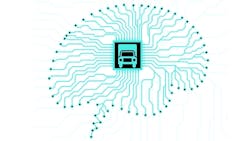Artificial Intelligence (AI) has become a popular topic again, after a 20-year cooling-off period. Whatever happened to AI and why did it go underground for so many years?
The answer is, AI didn’t vanish at all, but rather than emerging as a fully-formed incarnation of “The Jetsons” or “The Terminator,” AI went mainstream. People interact with AI every day, in so many ways that nobody thinks of it as the application of computer intelligence; it’s just another app, like Apple’s Siri or speech recognition capabilities in voice-mail applications like Microsoft Outlook.
In the industrial arena, supply chain planning solutions are AI-based, and most predictive analytics tools have some form of AI component. (There are numerous types of industrial robots, such as automated guided vehicles, that also have embedded intelligence, but for the purposes of this article, we’ll omit robotics from the discussion.)
The prototypical AI-based application is the expert system, which is basically a solution that embodies the knowledge of a human expert, and can make business decisions through a rule-based methodology that taps into that knowledge to mimic the expertise of the human expert. Expert systems are thus able to extrapolate solutions to unforeseen problems, giving them in effect the capacity to learn. These types of solutions date back to the 1970s, but really came of age during the Reagan years (parenthetically, I covered the AI field for about a dozen years, from the late 1980s until the Internet bubble burst in the early 2000s). And just about every manufacturing sector has developed and deployed expert systems down through the years—demand forecasting for computer production, chemical process control and monitoring, design optimization for automotive manufacturing, defect detection in electronics components, and a cost estimator for piece-part manufacturing, just to name a few.
Always On, Always Available
Lest you think expert systems have faded away, they continue to proliferate (though getting far less attention these days, as the popular media is more captivated these days by high-profile stunts, such as IBM’s chess- and Jeopardy-playing computers).
For instance, as one of the world’s major manufacturers of forklifts, Toyota Material Handling USA (TMHU) oversees support of an installed base of 500,000 vehicles throughout North America. Its dealer network includes 3,000 technicians, who receive more than 18,000 service calls every year. When you consider that roughly 70% of all manufactured goods are transported on a truck, and that the vast majority of those goods have to be loaded and unloaded with a lift truck, the supply chain can slow down or even come to a halt if a forklift unexpectedly has to be repaired or serviced.
TMHU teamed up with Exsys Inc., one of the longest-tenured developers of AI-based solutions, to develop TED (Toyota Electronic Diagnosis), an online expert system designed to speed up the diagnosis and repair of forklifts. A technician enters the appropriate model number and error code into the system, and then TED provides guidance in how to repair the problem, offering photos, diagrams and schematics.
“Now Toyota dealers and technicians have a one-stop source to assist their customers,” explains Cary Howie, TMHU technical services manager. “Less experienced technicians benefit from the experience of technicians with many years of diagnostic knowledge. Having TED on staff is like having another person available 24/7. TED never gets sick, and is always available.”
According to Howie, the cost to develop TED will be returned in the first year of use, with a higher ROI expected as future enhancements and forklift models are added to the system.
Knowing What to Do without Being Told
Predictive analytics is one of the disruptive technologies that will have a dramatic impact on supply chains and the people who run them, according to a recent survey of 900 U.S. supply chain executives conducted by Deloitte Consulting and MHI, a trade association for the material handling and logistics industry. Almost half (44%) of the respondents say that predictive analytics provide a competitive supply chain advantage, especially in today’s era of the “always-on” supply chains, notes Scott Sopher, principal at Deloitte Consulting.
Predictive analytics refers to the ability of computers to crunch through enormous amounts of data (Big Data) and make sense of it all. As the Deloitte/MHI report explains, when applied to supply chain problems, predictive analytics “allows managers to manage inventory better, plan more reliable transportation networks and reduce variability in lead times. This can enhance service levels, lower costs and improve the bottom line.”
One of the better known providers of analytics software is SAS, which describes its solutions as being based on “deep learning” neural networks, a type of AI solution that, in effect, teaches itself how to look for answers without being told exactly where to look. Food giant Nestlé, for instance, uses an SAS demand planning solution to improve forecasting accuracy while minimizing inventory overstocks. The company has roughly 10,000 SKUs to manage, which requires tight synchronization with seasonal and promotional marketing campaigns. The challenge for any consumer goods manufacturer, and particularly one as big as Nestlé, is to maintain high customer service levels without tying up too much capital in safety stock.
Predictability of demand for any given product is highly dependent on that product’s demand volatility, explains Marcel Baumgartner, Nestlé’s global lead for demand planning performance and statistical forecasting. “Especially for products that display wide fluctuations in demand, the choice and combination of methods is very important.”
By applying analytics, specifically a forecast value added methodology, when demand planning for highly volatile products with high volume, Nestlé has been able to more accurately anticipate customer behavior by integrating the impact of promotions and special offers into the statistical models, Baumgartner notes.
Read more on the smarter supply chain on IndustryWeek.
IndustryWeek is a sister publication of MH&L within Penton’s Manufacturing & Supply Chain Group.
About the Author

Dave Blanchard
Senior Director of Content
During his career Dave Blanchard has led the editorial management of many of Endeavor Business Media's best-known brands, including IndustryWeek, EHS Today, Material Handling & Logistics, Logistics Today, Supply Chain Technology News, and Business Finance. He also serves as senior content director of the annual Safety Leadership Conference. With over 30 years of B2B media experience, Dave literally wrote the book on supply chain management, Supply Chain Management Best Practices (John Wiley & Sons, 2021), which has been translated into several languages and is currently in its third edition. He is a frequent speaker and moderator at major trade shows and conferences, and has won numerous awards for writing and editing. He is a voting member of the jury of the Logistics Hall of Fame, and is a graduate of Northern Illinois University.
